Video of the Week:
Spider Mites
Ornamentals:
Tubakia Leaf Spot of Oak
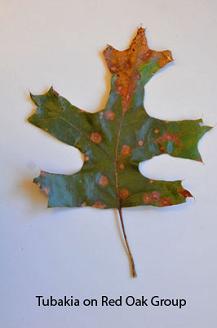
Squirrel Damage to Trees
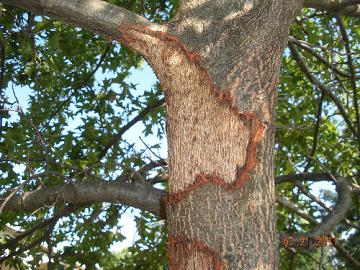
More serious damage is caused when squirrels strip the bark off of limbs or rarely, the trunk. Wounds can be quite large and the squirrel can effectively girdle the branch by removing all the bark completely around the circumference. Branches girdled in this way will die and the tree may be ruined if those branches are major.
Why squirrels do this is still a bit of a mystery. Some people think it is simply a means to sharpen their teeth or that they are seeking nesting material or water. Other people think that there are certain squirrels that are high-strung and cause this damage out of nervous energy.
If the damage is limited to snipping the ends off of branches, it is probably best to ignore the activity as the tree suffers little harm. But if real damage is occurring due to extensive bark removal, try feeding and watering them. If that doesn’t work, control may be necessary. Fox and gray squirrels are game animals and can be hunted in season where it is legal and safe to do so. They can also be trapped and moved away from the area they are causing damage. For more information on control, see http://www.bookstore.ksre.ksu.edu/pubs/L863.pdf . (Ward Upham)
Pests:
Cicada Killer Wasps
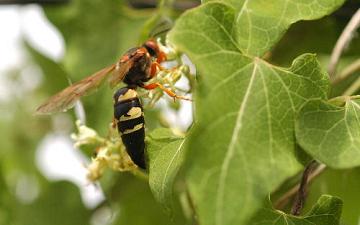
The cicada killer is a solitary wasp rather than a social wasp like the yellow jacket. The female nests in burrows in the ground. These burrows are quarter-size in diameter and can go 6 inches straight down and another 6 inches horizontally. Adults normally live 60 to 75 days from mid-July to mid-September and feed on flower nectar and sap. The adult female seeks cicadas on the trunks and lower limbs of trees. She stings her prey, flips it over, straddles it and carries it to her burrow. If she has a tree to climb, she will climb the tree so the can get airborne and fly with cicada back to the nest. If not, she will drag it. She will lay one egg per cicada if the egg is left unfertilized. Unfertilized eggs develop into males only. Fertilized eggs develop into females and are given at least two cicadas. Cicadas are then stuffed into the female’s burrow. Each burrow normally has three to four cells with one to two cicadas in each. However, it is possible for one burrow to have 10 to 20 cells.
Eggs hatch in two to three days, and larvae begin feeding on paralyzed cicadas. Feeding continues for four to 10 days until only the outer shell of the cicada remains. The larva overwinters inside a silken case. Pupation occurs in the spring. There is one generation per year.
Cicada killers are not dangerous, but they can be a nuisance. If you believe control is necessary, treat the burrows after dark to ensure the female wasps are in their nests. The males normally roost on plants near burrow sites. They can be captured with an insect net or knocked out of the air with a tennis racket during the day. Carbaryl (Sevin) or permethrin may be used for control.
If you would like more detailed information on cicada killers, see Bob Bauernfeind’s article in the July 10, 2015 Kansas Insect Newsletter at http://entomology.k-state.edu/doc/Newsletters/2015/KSInsectNewsletter12.pdf (Ward Upham)
Look for Bagworms Now
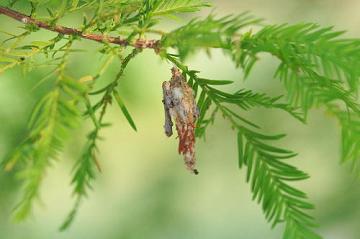
Insecticides commonly used for controlling bagworms include acephate (Orthene), permethrin (numerous trade names), cyfluthrin (Bayer Vegetable and Garden Insect spray), bifenthrin (Bug Blaster II, Bug-B-Gon Max Lawn and Garden Insect Killer), lambda-cyhalothrin (Spectracide Triazicide, Bonide Caterpillar Killer) and spinosad (Conserve; Borer, Bagworm, Leafminer and Tent Caterpillar Spray; and Captain Jack's Dead Bug Brew). Spinosad is an organic control that is very effective on this pest. Thorough spray coverage of foliage is essential for good control with any of these products. (Ward Upham)
Blister Beetles
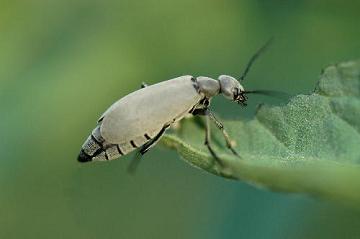
Some home gardeners like to use hand picking as a nonchemical method for controlling these large insects. However, wear gloves and use caution because these beetles contain a substance called cantharidin. This chemical is an irritant capable of blistering internal and external body tissues exposed to the chemical. On tender human skin, body fluids of adult blister beetles may cause large, erect, watery blisters.
Chemical control of blister beetles is also possible. Cyfluthrin (Bayer Vegetable and Garden Insect Spray) and gamma- or lambda-cyhalothrin (Spectracide Triazicide, Bonide Beetle Killer, Bonide Caterpillar Killer) can be used for control. Cyfluthrin has a 0 day waiting period and lambda-cyhalothrin has a 5-day waiting period on tomatoes. (Ward Upham)
Squash Vine Borer
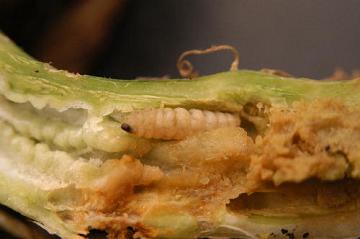
The adult of this insect is a clear-winged moth that resembles a wasp. The forewings are a dark metallic green but the rear wings are clear. The abdomen is orange with black spots. The larva is cream-colored and rather wrinkled. Adults emerge in the spring and lay eggs on or near susceptible plants. Larva bore into the plant and feed for about a month as they move toward the base. Mature larva will exit the plant, burrow into the soil and pupate where they remain until the next year. Each plant can have numerous borers. If you suspect squash vine borer, split the stem of a collapsed plant near where it enters the ground. Infested plants will be hollowed out and mushy and may contain borers. Unfortunately, there isn't much you can do at this late stage. Control measures should center on prevention.
Suggested preventative controls would include crushing the dull red eggs before they hatch, excavating larvae from stems before they cause much damage or using insecticide applications. Applications should begin when the vines begin to run (too late for that) and reapplied every seven to 10 days for three to five weeks. Direct the spray at the crown of the plant and the base of runners. Chemicals used for borer control in gardens are permethrin (Bug-No-More Yard & Garden Insect Spray; Eight Vegetable, Fruit & Flower Concentrate; Lawn, Garden, Pet and Livestock Insect Control; Lawn & Garden Insect Killer), bifenthrin (Hi-Yield Bug Blaster II, Bug-B-Gon Max Garden Insect Killer) or carbaryl (Sevin), applied as sprays or dusts. Continue on a 7 to 10 day reapplication schedule for 3 to 5 weeks. If plants wilt, look for the presence of holes and ooze. However, in extreme heat, these plants will wilt in the afternoon even if undamaged by this insect. (Ward Upham)
Miscellaneous:
Watering May Be Needed This Summer
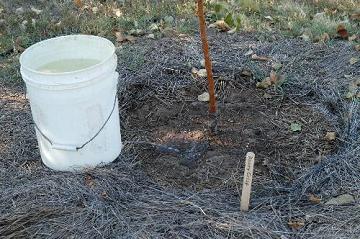
Rain saturated soils can damage root systems. Excess water drives oxygen out of the soil as pore spaces are filled with water. Every living cell in a plant must have oxygen to live. If there is no oxygen, roots will die. Therefore, many of our plants may need to be babied through the summer.
Newly planted trees are especially vulnerable as they have not established the extensive root system needed to absorb enough water during hot, dry, windy summers. Even trees two or three years old should receive special care even if the root system was not damaged by saturated soils.
Deep, infrequent watering and mulching can help trees become established. Newly transplanted trees need at least 10 gallons of water per week, and on sandy soils they will need that much applied twice a week. The secret is getting that water to soak deeply into the soil, so it evaporates more slowly and is available to the tree’s roots longer. One way to do this is to drill a small hole (1/8") in the side and near the bottom of a 5-gallon bucket and fill it with water. Let the water dribble out slowly next to the tree. Refill the bucket once, and you have applied 10 gallons. Very large transplanted trees and trees that were transplanted two to three years ago will require more water.
A perforated soaker hose is a great way to water larger trees, a newly established bed or a foundation planting. See the accompanying article for an inexpensive way to water trees.
In sunbaked soil, you may need to rough up the surface with a hoe or tiller to get water to infiltrate easily. It may be helpful to set the kitchen oven timer, so you remember to move the hose or shut off the faucet. If you are seeing surface runoff, reduce the flow.
Regardless of method used, soil should be wet at least 12 inches deep. Use a metal rod, wooden dowel, electric fence post or something similar to check depth. Dry soil is much harder to push through than wet. Record the time that was required to reach 12 inches and then use a time clock for any future waterings. (Ward Upham)
Inexpensive Method of Watering Trees
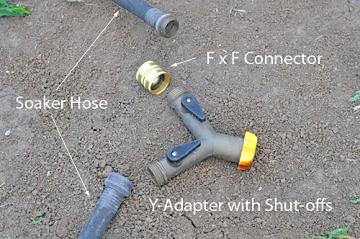
Soaker hoses are notorious for non-uniform watering. In other words, you often receive too much water from one part of the hose and not enough from another. Hooking both the beginning and the end of the soaker hose to a Y-adapter helps equalize the pressure and therefore provide a more uniform watering. The specific parts you need are shown in the photo above and include the soaker hose, Y-adapter and female to female connector.
It is also helpful if the Y-adapter has shut off valves so the volume of flow can be controlled. Too high a flow rate can allow water to run off rather than soak in.
On larger trees, the soaker hose can circle the trunk at a distance within the dripline of the tree but at least ½ the distance to the dripline. The dripline of the tree is outermost reach of the branches. On smaller trees, you may circle the tree several times so that only soil which has tree roots will be watered. (Ward Upham)
Contributors: Ward Upham, Extension Associate
 RSS Feed
RSS Feed
